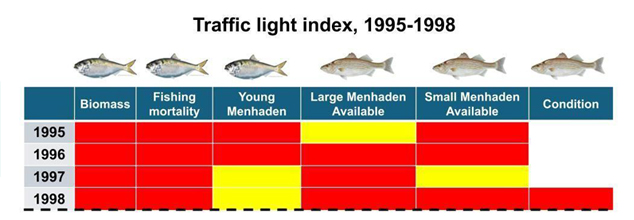Menhaden Traffic Light Index
What is the Menhaden Traffic Light Index?
The Menhaden Traffic Light index is a new peer-reviewed tool developed by the Maryland Department of Natural Resources (DNR).
This analysis is driven by science and data collected by Maryland DNR from the Maryland Chesapeake Bay.
The tool helps us understand how the balance between menhaden and striped bass changes over time and provides insight to the important question:
Are there enough menhaden in Maryland’s portion of Chesapeake Bay for resident striped bass to eat?
This tool uses a simple “traffic light” system of green (good), yellow (caution), and red (poor) to communicate the status of different measures, which reveal the forage balance of these two species.
- 6 core indicators, 3 for menhaden and 3 for resident striped bass (those that spend their lives in the Bay), measure the predator-prey dynamic between these two species.
- Indicators are updated annually according to the Index’s statistically-based rating system using newly-available data.
- It uses existing data collected from Bay menhaden fisheries and DNR surveys.
- This traffic light index is not directly tied to management measures.
 2024 Status Summary:
2024 Status Summary:
- Primarily green indicators.
- The appearance of one poor and one uncertain indicator in 2024 is of concern.
- Adult menhaden biomass abruptly fell to poor in 2024.
- It was good from 2018-2024.
- Juvenile menhaden abundance was very good in 2023-2024 for current ecological conditions.
- Fishing mortality of Menhaden has been categorized as good (low deaths from fishing activities) from 2018-2023.
- A 2024 estimate was not available. Age 1+ Menhaden availability was within the caution boundaries.
Menhaden Indicators (prey species)
-
Harvestable Menhaden Biomass Index: This is an index of the total weight of adult menhaden (one year old and older) in Maryland’s part of the Bay. These are fish that are big enough to be eaten by resident striped bass and also big enough for the commercial fishery. It’s based on the average pounds of menhaden harvested per days fished in Potomac River fish traps called pound nets.
-
Young Menhaden Abundance (Age-0 Index): This shows how abundant young menhaden were in the Bay in a given year, compared to other years. It gives a sense of whether there will be enough small menhaden for resident striped bass that year. This is the same survey that DNR uses to measure young striped bass abundance.
-
Trend in Fishing Mortality on Menhaden (Relative Fishing Mortality): This tracks whether deaths from fishing are increasing, decreasing, or staying steady. It tells us whether menhaden fishing in the entire Bay could be affecting striped bass in Maryland.
Striped Bass Indicators (predatory species)
-
Large Menhaden Availability for Resident Striped Bass: This indicator looks at the ratio of medium and large (ages one year and older) menhaden to mid-sized striped bass (18–28 inches long). These striped bass are typically 3 to 6 years old. A high ratio means more prey for these fish to eat.
-
Small Menhaden Availability for Resident Striped Bass: This measures the ratio of small (juvenile, under one year old) menhaden to striped bass 18-28 inches. These small menhaden are an important food source, especially during late summer through winter.
-
Striped Bass Condition: This indicator answers: Are striped bass getting enough to eat? It’s based on the percentage of striped bass with visible fat in their body cavity. Well-fed striped bass have fat deposits in their body cavity.
How Was the Traffic Light Index Developed?
The Menhaden Traffic Light Index utilizes data from commercial harvest records and DNR surveys in a cost-effective and timely approach to display Menhaden’s past and current status as prey for resident striped bass in Maryland’s portion of the Bay. To build the index, Maryland DNR Fishing and Boating Services scientists analyzed 27 years of data (1995–2021) from surveys. This reference period was selected because it coincides with striped bass management changing to higher size limits and low fishing mortality. As the striped bass population rebounded, that raised demand for their food.
The scientists defined boundaries for what counts as “good,” “caution,” or “poor” based on trends during that period. The stoplight index technique was developed in the 1990s as part of the precautionary policy approach, which suggests taking measures to prevent harm even if cause and effect is uncertain.
The methods and results were peer reviewed by outside scientists with relevant credentials working beyond the Chesapeake Bay region.
 2024 Update
2024 Update
Historical Perspective
The Menhaden Traffic Light Index provides insight into the question, “Are there enough menhaden for striped bass to eat in Maryland’s Chesapeake Bay?”, in the present and the future. It provides a historical perspective on the balance between these two species. Over the last several decades, management of menhaden in Chesapeake Bay has changed to increase protection for this important fish. Reviewing the management history alongside the traffic light indicators suggests that
it is plausible that limiting large-scale fishing for Menhaden in the Bay has had a positive effect on the balance between menhaden and striped bass.

See larger version
Core indicators were entirely or mostly red. Striped Bass were considered recovered after a period of depletion. The index indicates an imbalance in the number of predators (striped bass) to the available prey (menhaden).
Traffic light indicators became primarily yellow, with a few red core indicators.

A transition toward a better balance between striped bass and menhaden was indicated. *A cap on the Menhaden reduction fishery in the Bay was imposed in 2006 and remains. Red indicators diminished, yellow core indicators became predominant, and good green indicators began to appear.

See larger version
Traffic Light Index indicators were predominantly green with some yellow indicators interspersed and a single red indicator. Coastal quotas were introduced in 2013.
